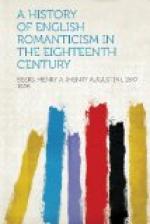[53] Book I. stanzas 32-34.
CHAPTER IX.
Ossian
In 1760 appeared the first installment of MacPherson’s “Ossian."[1] Among those who received it with the greatest curiosity and delight was Gray, who had recently been helping Mason with criticisms on his “Caractacus,” published in 1759. From a letter to Walpole (June 1760) it would seem that the latter had sent Gray two manuscript bits of the as yet unprinted “Fragments,” communicated to Walpole by Sir David Dalrymple, who furnished Scotch ballads to Percy. “I am so charmed,” wrote Gray, “with the two specimens of Erse poetry, that I cannot help giving you the trouble to inquire a little farther about them; and should wish to see a few lines of the original, that I may form some slight idea of the language, the measures and the rhythm. Is there anything known of the author or authors; and of what antiquity are they supposed to be? Is there any more to be had of equal beauty, or at all approaching it?”
In a letter to Shonehewer (June 29,) he writes: “I have received another Scotch packet with a third specimen . . . full of nature and noble wild imagination."[2] And in the month following he writes to Wharton: “If you have seen Stonehewer, he has probably told you of my old Scotch (rather Irish) poetry. I am gone mad about them. They are said to be translations (literal and in prose) from the Erse tongue, done by one MacPherson, a young clergyman in the Highlands. He means to publish a collection he has of these specimens of antiquity, if it be antiquity; but what plagues me, is, I cannot come at any certainty on that head. I was so struck, so extasie with their infinite beauty, that I writ into Scotland to make a thousand enquiries.” This is strong language for a man of Gray’s coolly critical temper; but all his correspondence of about this date is filled with references to Ossian which enable the modern reader to understand in part the excitement that the book created among Gray’s contemporaries. The letters that he got from MacPherson were unconvincing, “ill-wrote, ill-reasoned, calculated to deceive, and yet not cunning enough to do it cleverly.” The external evidence disposed him to believe the poems counterfeit; but the impression which they made was such that he was “resolved to believe them genuine, spite of the Devil and the Kirk. It is impossible to convince me that they were invented by the same man that writes me these letters. On the other hand, it is almost as hard to suppose, if they are original, that he should be able to translate them so admirably.”




